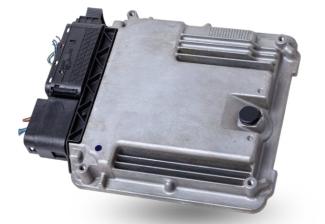The Role of Electronic Control Units in the Future E-Mobility
We all enjoy heated seats, infotainment systems, automatic transmissions, and power windows, but have we ever considered how these (and many more) features are continuously being added under the hood? It stands to reason that at some point, there simply won’t be any more room for yet another electronic control unit (ECU) to control the inevitable dashboard cappuccino maker and milk frother.
While the last two features are clear exaggerations, they nonetheless represent a very real problem. Modern vehicles are arguably more computer than transportation method, relying on the computational strength of two dozen personal computers to operate. The question then becomes, how do auto manufacturers add more features within increasingly tight confines? In this article, we’ll look at ECUs and see how automakers are adapting to provide more features with less.
What is an Electronic Control Unit and How Does it Work?

As the reader may be able to infer, an electronic control unit (or ECU, for short), is a device used to control a singular electronic function. The more sophisticated the vehicle (i.e., the more features), the more ECUs one is apt to find under the hood. Many of the vehicles currently rolling off the production line can contain upwards of 100 ECUs; each controlling various features or sub systems ranging from power steering and power windows to climate controls and safety systems.
In spite of their diminutive size, each ECU will contain a chip capable of executing its own software along with the necessary power/communication inputs and outputs. When an input signal is received, the software/firmware will process the information and relay the appropriate output function. The time between input signal and output command is so little that actions are executed seemingly instantaneously. Consider for a moment the process involved in rolling down a power window. Pressing a door mounted control will send an input signal to the associated ECU where the software determines which window requires adjustment (driver or passenger side and front or back), then sends an output signal to the corresponding motor that executes the command. Not all ECU-controlled functions are executed by the user; for example, sensors are used to relay impact signals to the ECU that controls airbag deployment, which in turn relays the necessary output signal to deploy the required airbags.
How Manufacturers are Addressing the Need for More ECUs
Since manufacturers are constantly adding new features to their vehicles, it should come as no surprise that the space available to house the ECUs required to control said features is shrinking. Incrementally adding ECUs in a piecemeal fashion may strike the reader as a rather inefficient approach to feature deployment, particularly considering how modern vehicles are often marketed as modern and efficient methods of conveyance. The logical solution would be to develop a method that would allow more ECU controls to be added while maximizing the available space. That logical solution of course, would entail the consolidation of ECUs.
Some thought is needed to ensure ECUs are consolidated appropriately, based on factors such as common system, executable function, and software applications that can operate in parallel. For example, rather than having a dedicated ECU for each heating and cooling function, a manufacturer may choose to consolidated multiple ECUs that perform climate control functions (e.g., heated seats, mirror defrost, heated steering wheel, and/or general climate control can conceivably and logically be consolidated into a dedicated domain controller). Similarly, the ECUs responsible for executing safety functions could also be consolidated.
How Consolidating ECUs will Help
While there is no crystal ball that allows us to peer into the future, we can rely on historical trends to infer the importance associated with consolidating ECUs. Case in point – the number of ECUs located within a standard vehicle has more than doubled in the last decade. As vehicles are arguably becoming more “software-defined”, it stands to reason that this trend will continue for the foreseeable future. Space-saving is not the only advantage to consolidating ECUs. It’s expected that consolidation of ECUs will have a positive effect on power consumption and a vehicle’s weight, two factors that are intrinsically tied to performance.
ECU consolidation does come with some challenges, however. First, consolidated ECUs will likely need to rely on more robust software, which in turn could pose additional integration challenges. Consolidation may also cause production delays as more testing will be required to ensure everything is functioning as intended.
An interesting solution to these challenges comes in the form of multi-core processors. The idea being that, unlike single processors that must execute one process at a time, multi-core processors can execute multiple processes in parallel without interfering with any other commands.
Consolidation Efforts Critical to the Future of ECU Integration
Electronic Control Units have been and will continue to be integral to the performance and safety of each and every vehicle on the road. Having said that, it is clear that a new approach must be taken in order to accommodate an ever increasing number of ECUs. Little doubt remains that, given the sheer number of ECUs required by an average vehicle, a consolidated approach is unavoidable.
If you are interested in learning more about ECUs, how they are used, and how to work with them, check out George Brown College’s EV Technician program or speak to a Program Consultant today.
